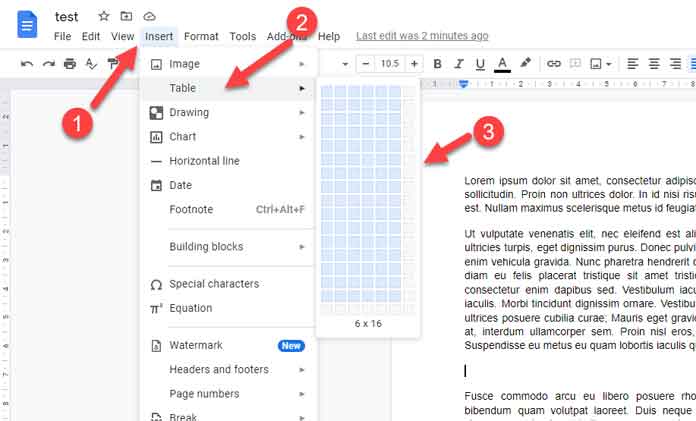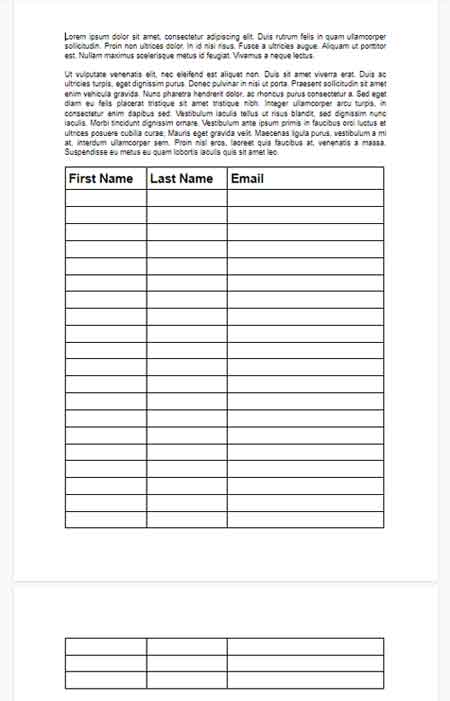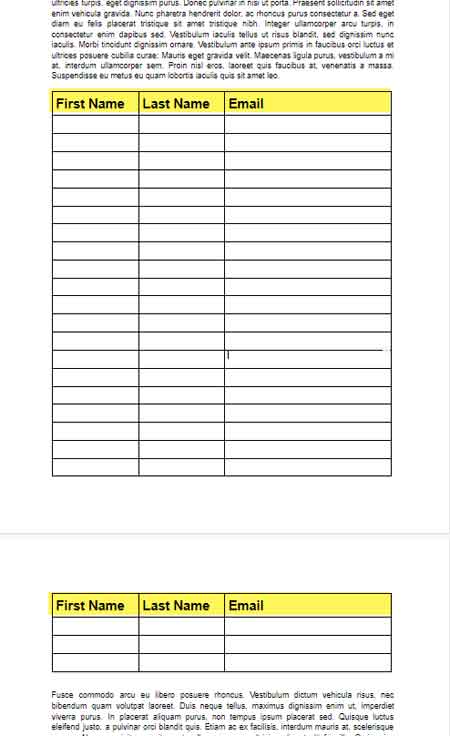This time, let’s learn how to create a table and Pin/Unpin header rows in Google Docs.
The purpose of a table in Docs is to help users organize data in rows and columns.
Once created, there are many customization options available to format a table, and one of them is Pin and Unpin header rows.
If you have created a table in Google Docs that crosses more than one page, you can use this relatively new feature.
What does it do then?
When you turn this feature on, Google Docs will duplicate or pin the header row(s) at the top of each page that the table spans.
Earlier, we used a workaround method to pin and unpin table header rows in Google Docs.
You can read that here – How to Repeat Header in Google Docs Table – Workaround.
We will start with creating a table.
How to Create a Table in Google Docs
You can follow the below quick steps to create a table in Google Docs.
Within a Docs document, Go to the menu Insert > Table.
Then on the table grid, move your cursor pointer to highlight your desired number of rows and columns to insert and click.

This way, we can create a table in Google Docs.
Currently, Google Docs supports a maximum of 20 x 20 cells.
Once created, if you want, you can add more rows and columns to the inserted table in Google Docs.
Before learning how to Pin and Unpin Header Rows in Google Docs, let’s go-to essential table customization options.
Adding, Deleting, Distributing Rows or Columns
You can add, delete rows or columns by accessing the shorthand menu by right-clicking any cell in a Docs Table.
There you can find the below options.
- Insert columns to the right.
- Insert columns to the left.
- Delete column.
- Insert row above.
- Insert row below.
- Delete row.
To add or delete multiple rows or columns in a table in Google Docs, select more than one cell vertically (rows) or horizontally (columns).
Then right-click and select the menu option that you want.
When you have very few columns in the created table, the quickest way to add rows at the end of a table is as follows.
Go to the very last cell in the table. Then click the tab button. It will insert a new row at the bottom. Repeat it.
What’s distributing rows and columns in a Docs Table?
You will see both options within the shorthand menu.
If you have adjusted the size of any rows or columns, you can use these features.
Click on any cell and select either of the options (distribute rows/columns) to auto-adjust all rows/columns to equal size.
Pin and Unpin Table Header Rows in Google Docs
First, create a table as detailed above in Google Docs, and please do make sure that it crosses more than one page.

The first row is the header of the table. As per the example, it contains the labels “First Name,” “Last Name,” and “Email.”
How to pin this header to make it appear at the top of each page that the table spans?
Here are the steps to pin a header row in a table in Google Docs.
- Click in any cell on your table.
- Go to Format > Table > Table properties.
- Enable Pin header row(s) and specify 1, i.e., the number of rows to pin in our case.
- Click OK.
If you want to pin more than one row, specify that number in the third step.

This way, we can pin header rows in a table in Google Docs.
How to Unpin a header row of a table in Google Docs?
Just follow the above four steps. But in the third step, uncheck the Pin header row(s).
That’s all.
I hope the details helped you learn how to create a table and Pin/Unpin header rows in Google Docs.
Thanks for the stay. Enjoy!






















Thanks so much for your clear and concise help!